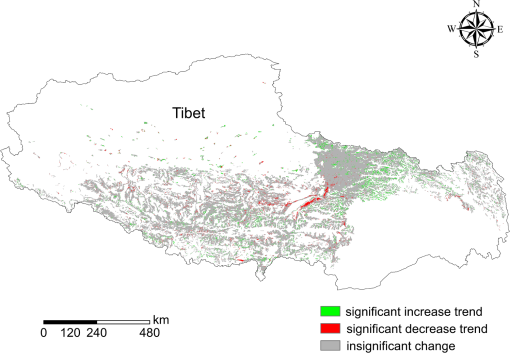|
|
1.IntroductionGross primary production (GPP) and above-ground biomass (AGB) play important roles in the carbon cycling of terrestrial ecosystems and are related to plant growth, ecosystem respiration, and net ecosystem exchange.1–4 Understanding the response of GPP and AGB to warming is crucial for predicting future changes in the carbon cycling. Inconsistent results on the response of GPP and AGB to warming have been observed with respect to vegetation types and climate conditions.5–8 Experimental warming is a key tool for understanding the effects of climate change on various terrestrial ecosystems, and various warming simulation equipment has been applied worldwide.9–11 As one of the most prevalent warming simulation approach, open-top chambers (OTCs) have their own attributive advantages, such as being cheap and transportable and requiring no electricity and high-level technique equipment,12,13 and thereby are very suitable for remote areas where electricity is often a limiting factor. In addition, OTCs probably alter relative humidity, precipitation, and wind speed, whereas the unwanted effects are not always significant.9,12,13 However, OTCs have been widely applied in various ecosystems, including arctic tundra ecosystems,14,15 alpine meadows,16,17 swamp meadows,18 salt marshes,19 forest ecosystems,20 and agriculture ecosystems.21 The Tibetan Plateau is experiencing significant climate warming, and the expected warming trend is much greater than average.22,23 The alpine meadow plays a key role in the region carbon budget in China3,24 and is one of the most sensitive terrestrial ecosystems to climate change among various grasslands in China.25,26 About one-third of the Tibetan Plateau is covered with alpine meadow, which is one of the major pasturelands on the Tibetan Plateau.27,28 Many warming experiments have been performed in the alpine meadow on the Tibetan Plateau in order to understand their responses to warming, whereas there are still uncertainties about warming effects on carbon flux.16–18,29 On the other hand, only a few studies are focused on the response of GPP and AGB to warming in the alpine meadow of Tibet along an elevation gradient. Therefore, here we set up a field warming experiment in an alpine meadow at three elevations (i.e., 4313, 4513, and 4693 m) on the Northern Tibetan Plateau to investigate warming effects on GPP and AGB. A recent meta-analysis showed that experimental warming enhanced ecosystem photosynthesis and AGB.30 Therefore, we hypothesized that experimental warming could increase GPP and AGB of alpine meadow in this study. 2.Materials and Methods2.1.Study AreaThe study area (30°30′ to 30°32′ N, 91°03′ to 91°04′ E) was located at Damxung Grassland Observation Station, Tibet Autonomous Region of China. The annual mean sunlight is 2880.9 h and the annual mean solar radiation is . The annual mean air temperature is 1.3°C, ranging from the lowest value () in January to the maximum (10.7°C) in July. Annual mean precipitation is around 476.8 mm, with occurring in the period from June to August.3 The annual potential evapotranspiration is . The soil freezing duration is from November to January. The soil texture is sandy loam. The soil layer is 0.5 to 0.7 m thick, with organic matter of 0.3 to 11.2%, total nitrogen of 0.03 to 0.49%, and pH of 6.0 to 6.7.28 The typical vegetation type in the study area is Kobresia-dominated alpine meadow.26 Roots are mainly concentrated in the topsoil layer (0 to 20 cm). Annual air temperature significantly increased 1.6°C, while change in annual precipitation was not significant from 1963 to 2010 in this study area.8 2.2.Experimental DesignThe experiment was set up on a south-facing slope on the Nyainqentanglha Mountains at three elevations (i.e., 4313, 4513, and 4693 m). Four OTCs were randomly established at each alpine meadow site in May 2010. The OTCs were 1.45 and 1.00 m in bottom and top diameters and 0.40 m in height.26 The OTCs were made of 3-mm thick polycarbonate. The OTCs remained on the plots year round. One control plot was randomly set up in the vicinity of each OTC. There was distance between plots. Soil temperature at the depth of 0.05 m, soil water content at the depth of 0.10 m (SWC), air temperature (), and relative humidity (RH) at the height of 0.15 m were continuously automonitored using meteorological towers. All the channels were connected to data loggers (HOBO weather station, Onset Computer, Bourne, MA). Vapor pressure deficit (VPD) was the difference between saturation and actual vapor pressures, which were calculated using measured and RH.3 Experimental warming significantly increased daily by 1.08, 1.81, and 0.94°C and daily VPD by 0.05, 0.05, and 0.03 kPa at elevations 4313, 4513, and 4693 m from June to September in 2012, respectively. In contrast, daily SWC was significantly decreased by , , and , respectively, at elevations 4313, 4513, and 4693 m. OTCs-induced increment in and VPD and decrement in SWC were in line with previous studies that indicated the warming and drying trends across the Tibetan Plateau.31,32 Daily and VPD during the study period significantly decreased with increasing elevation along the elevation gradient (4313 to 4693 m), whereas daily SWC significantly increased with increasing elevation. Precipitation increases with increasing altitude along the elevation gradient.8 However, there were no significant differences between control and warmed plots for canopy coverage and topsoil (0 to 20 cm) microbial biomass in August 2011.26 2.3.Normalized Difference Vegetation IndexPhotographs in a subplot in the center of each plot were taken using a Tetracam Agricultural Digital Camera (ADC, Tetracam Inc., Chatsworth, CA) for each plot from late June to September in 2012. The camera has green (520 to 600 nm), red (630 to 690 nm), and near-infrared (760 to 900 nm) bands. The camera can produce with an 8.0-mm lens. When any one study target photograph was taken, the lens of ADC was parallel to the ground and the height of the ADC was to limit the variations in spatial resolution and field of view. At the height of 1.0 m, the spatial resolution and field of view are and , respectively. The field of view () is larger than that of the ground target view () to reduce the edge effect. Calibration photographs of a white Teflon plate provided by the Tetracam manufacturer were taken before and after each batch of the study target photographs. The calibration photographs were also taken when light condition changed remarkably. All the study target photographs were processed using the PixelWrench2 software (included with the ADC) to obtain normalized difference vegetation index (NDVI), and photographs of the white Teflon calibration plate were used to produce the calibration parameters.33,34 Band saturation may occur, which could reduce the dynamic range of NDVI.35 Since the NDVI value was in our study area, the NDVI saturation could not generally happen. In addition, we used the moderate-resolution imaging spectroradiometer (MODIS) vegetation indices data (MOD13A3, Collection 5, 1 km spatial resolution and monthly composite temporal resolution) over the Tibetan alpine meadow from June to September during 2000 to 2012. 2.4.GPP AlgorithmGPP was calculated based on the MODIS GPP algorithm. Our previous one study has validated the GPP algorithm using surface observed data in an alpine meadow of Tibet, which is near to our study sites.3 The MODIS GPP algorithm is based on a light use efficiency (LUE) approach.36 LUE is combined with absorbed photosynthesis active radiation (PAR) by vegetation canopy (APAR) to calculate GPP () as follows: LUE is calculated as where is the maximum light use efficiency or the ecosystem apparent quantum yield (). The was set to be in this study.3 and are the two attenuation scalars with a range from 0 to 1. Daily minimum () and daytime average VPD were used to calculate and as follows:36APAR can be calculated as where FPAR is the fraction of absorbed PAR by the vegetation canopy. FPAR was estimated using the observed NDVI values in this study as follows:37 where and , respectively.37In this study, we used different model parameters to calculate GPP (Table 1).3,37 Table 1Values for Ta min_max (°C), Ta min_min (°C), VPDmax (kPa), VPDmin (kPa), NDVImax, NDVImin, SRmax, and SRmin used in gross primary production (GPP) calculation and average GPP (g C m−2 d−1) comparisons between the control plots and open-top chambers (OTCs) across all the measuring dates at elevations 4313, 4513, and 4693 m, respectively.
2.5.AGB EstimationAGB was estimated using a nondestructive approach.38 Briefly, photographs were also taken using the ADC outside the treatment plots and then above-ground plant parts were harvested, dried, and weighed in the three alpine meadow sites along the elevation gradient during the growing season in 2012. A regression equation (, , , ) between AGB and NDVI was developed using the data collected from outside the treatment plots across the three alpine meadows along the elevation gradient. 2.6.Statistical AnalysisFor a specific site, repeated-measures analysis of variance was used to estimate the main and interactive effects of experimental warming and sampling dates on GPP and AGB. Linear regression analyses between GPP, AGB and , SWC were conducted, respectively. All the statistical analyses were performed using the SPSS software (version 16.0; SPSS Inc., Chicago, IL). 3.Results and DiscussionBased on averaging the air temperature and precipitation data of all the 38 weather stations in Tibet, the mean air temperature (June to September) showed a significant increase trend (), while average total precipitation showed an insignificant decrease trend () from 2000 to 2012 (Fig. 1). On the other hand, there was no significant positive trend () for MODIS-based NDVI over the Tibetan alpine meadows during the past 13 years (2000 to 2012) (Fig. 1). However, and 2.9% of the alpine meadow area showed significant increase and decrease trends, respectively (Fig. 2). Therefore, warming could not always increase NDVI.31 This finding was supported by the effects of experimental warming on NDVI in the alpine meadow at the three elevations. In detail, experimental warming significantly decreased the average NDVI by 15.6% at elevation 4313 m (, ), but only tended to decrease the average NDVI by 8.1% (, ) and 5.6% (, ) at elevations 4513 and 4693 m, respectively. Fig. 1The variations of (a) mean air temperature (°C) and total precipitation (mm) and (b) spatial average normalized difference vegetation index (NDVI) over Tibetan alpine meadow during 2000 to 2012. The data during the period from June to September were used. 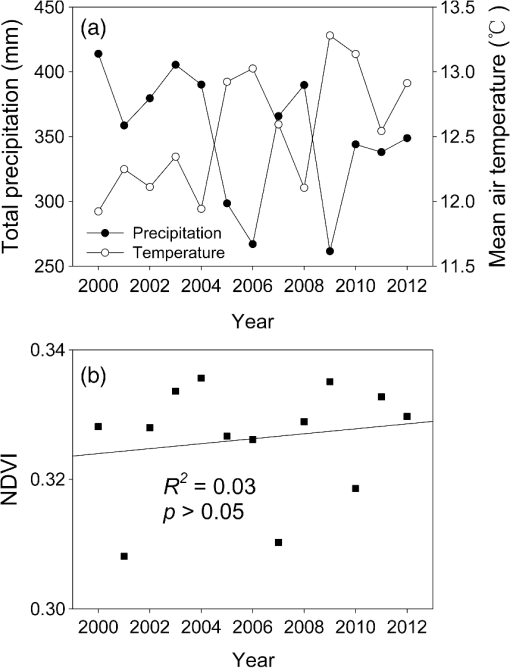 GPP and AGB showed similar seasonal dynamics among the three alpine meadow sites regardless of experimental warming, respectively (Fig. 3). The significant seasonal changes of GPP and AGB were similar to previous studies.39–41 Fig. 3Effects of experimental warming on gross primary production (GPP, ) and above-ground biomass (AGB, ) in the three alpine meadow sites located at elevations 4313 m [(a) and (d)], 4513 m [(b) and (e)], and 4693 m [(c) and (f)] on the Northern Tibetan Plateau, respectively. Error bars represent standard errors (). Here GPP data were GPP1. 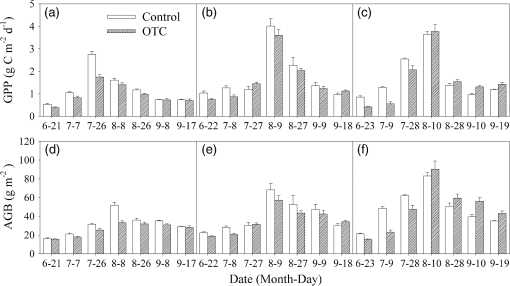 The average GPP in the control and warmed plots at elevations 4313, 4513, and 4693 m were 1.07 to and 0.83 to , 1.54 to and 1.38 to , and 1.54 to and 1.40 to , respectively, which were close to previous observations conducted near our study sites.3,40 The average AGB in the control and warmed plots at elevations 4313, 4513, and 4693 m were and , and , and and , respectively, which were close to previous observations conducted near our study sites.41,42 However, AGBs in this study were much lower than the reported values in the alpine meadow of Haibei Alpine Meadow Ecosystem Research Station.43 The difference between the two studies was probably due to SWC in the Haibei Alpine Meadow Ecosystem Research Station being larger and the growing-season average in the Haibei Alpine Meadow Ecosystem Research Station being closer to the optimum in the alpine meadow on the Tibetan Plateau compared to this study.8,26 Contrary to our expectation, experimental warming significantly decreased average GPP and AGB by 21.7 to 23.0% and 17.1% at elevation 4313 m across all the sampling dates, respectively (). However, the declines of average GPP and AGB at elevations 4513 and 4693 m were not statistically significant. The negative effects of experimental warming on average GPP and AGB were in accordance with some previous studies.6,7,44,45 GPP and AGB significantly increased with increasing SWC across warming treatments along the elevation gradient (Fig. 4). The positive relationships among GPP, AGB, and SWC were in line with previous studies.5,8,39,40,46 Similarly, Reichstein et al.36 showed that a limitation of water caused a reduction in GPP during the European 2003 summer. Fu et al.3 found that GPP during the 2006 summer was largely decreased by soil drying in an alpine meadow of Tibet compared to other years. Fu et al.39 indicated that GPP was positively correlated with SWC across three grasslands in China. AGB of alpine grassland increased with precipitation at various spatial scales on the Tibetan Plateau.4,8 Li et al.18 indicated that AGB of a swamp meadow was significantly larger than that of an alpine meadow due to a higher SWC in the Fenghuoshan region on the Tibetan Plateau. Therefore, experimental warming-induced significant or fractional declines in GPP and AGB may be partly related to experimental warming-induced soil drying.6,18,47,48 Fig. 4Relationships among growing-season average GPP (), AGB (), and soil water content () [(a) and (c)] and between growing-season average GPP, AGB, and air temperature (, °C) [(b) and (d)] across elevation and warming treatment in the alpine meadow on the Tibetan Plateau. Here GPP data were GPP1. 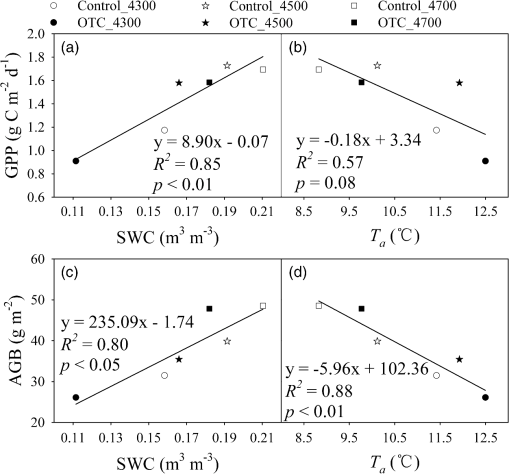 GPP was weakly decreased with increasing , while AGB was significantly reduced across warming treatments along the elevation gradient (Fig. 4). This finding was in accordance with some previous studies, which indicated that there was optimum temperature for GPP and AGB at various spatial scales.5,8,48,49 Therefore, experimental warming-induced increment in was probably beyond the optimum temperature for GPP and AGB. However, the relationships among GPP, AGB, and were regulated by water availability.3,8,18 The different responses of GPP and AGB to experimental warming among the three alpine meadow sites could be dependent on different soil moisture and conditions.8,18 The optimum was for AGB in the alpine meadow of Tibet.8 GPP and AGB increased with increasing water availability.3,4 In this study, at elevation 4693 m was closest to the optimum and water availability increased with increasing elevation. That is, experimental warming-induced warmer and drier conditions deviated from the optimum and water availability conditions for GPP and AGB, while the deviation magnitude may decrease with increasing elevation. Similarly, the largest declines in GPP caused by experimental warming occurred in summer when warming-induced drying stress was the highest.6 The lesser decrease of GPP caused by summer drought in an evergreen forest compared to a deciduous forest may be attributed to its relative high SWC condition during normal years.50 AcknowledgmentsThis work was funded by the National Natural Science Foundation of China (No. 41171084) and the Natural Science Foundation of Tibet Autonomous Region (Name. Response of species richness and above-ground biomass to warming in the alpine meadow of Tibet). ReferencesS. F. Oberbaueret al.,
“Tundra fluxes in response to experimental warming across latitudinal and moisture gradients,”
Ecol. Monogr., 77
(2), 221
–238
(2007). http://dx.doi.org/10.1890/06-0649 ECMOAQ 0012-9615 Google Scholar
J. M. Welkeret al.,
“ exchange in three Canadian High Arctic ecosystems: response to long-term experimental warming,”
Glob. Change Biol., 10
(12), 1981
–1995
(2004). http://dx.doi.org/10.1111/gcb.2004.10.issue-12 1354-1013 Google Scholar
G. Fuet al.,
“Calibration of MODIS-based gross primary production over an alpine meadow on the Tibetan Plateau,”
Can. J. Rem. Sens., 38
(2), 157
–168
(2012). http://dx.doi.org/10.5589/m12-023 CJRSDP 0703-8992 Google Scholar
Y. H. Yanget al.,
“Aboveground biomass in Tibetan grasslands,”
J. Arid Environ., 73
(1), 91
–95
(2009). http://dx.doi.org/10.1016/j.jaridenv.2008.09.027 JAENDR 0140-1963 Google Scholar
L. Jianget al.,
“Water- and plant-mediated responses of ecosystem carbon fluxes to warming and nitrogen addition on the Songnen grassland in Northeast China,”
PLoS One, 7
(9), e45205
(2012). 1932-6203 Google Scholar
H. J. De Boecket al.,
“How do climate warming and species richness affect fluxes in experimental grasslands?,”
New Phytol., 175
(3), 512
–522
(2007). http://dx.doi.org/10.1111/nph.2007.175.issue-3 NEPHAV 0028-646X Google Scholar
Z. T. Wuet al.,
“Responses of ecosystem carbon cycling to climate change treatments along an elevation gradient,”
Ecosystems, 14
(7), 1066
–1080
(2011). http://dx.doi.org/10.1007/s10021-011-9464-4 ECOSFJ 1432-9840 Google Scholar
Z. Wanget al.,
“Causes for the unimodal pattern of biomass and productivity in alpine grasslands along a large altitudinal gradient in semi-arid regions,”
J. Veg. Sci., 24
(1), 189
–201
(2013). http://dx.doi.org/10.1111/jvs.2012.24.issue-1 JVESEK 1100-9233 Google Scholar
G. M. Marionet al.,
“Open-top designs for manipulating field temperature in high-latitude ecosystems,”
Glob. Change Biol., 3
(Suppl. 1), 20
–32
(1997). http://dx.doi.org/10.1111/j.1365-2486.1997.gcb136.x 1354-1013 Google Scholar
J. Harteet al.,
“Global warming and soil microclimate: results from a meadow-warming experiment,”
Ecol. Appl., 5
(1), 132
–150
(1995). http://dx.doi.org/10.2307/1942058 ECAPE7 1051-0761 Google Scholar
W. T. Peterjohnet al.,
“Soil warming and trace gas fluxes: experimental design and preliminary flux results,”
Oecologia, 93
(1), 18
–24
(1993). OECOBX 0029-8549 Google Scholar
A. DabrosJ. W. FylesI. B. Strachan,
“Effects of open-top chambers on physical properties of air and soil at post-disturbance sites in northwestern Quebec,”
Plant Soil, 333
(1–2), 203
–218
(2010). http://dx.doi.org/10.1007/s11104-010-0336-z PLSOA2 0032-079X Google Scholar
P. De Frenneet al.,
“The use of open-top chambers in forests for evaluating warming effects on herbaceous understorey plants,”
Ecol. Res., 25
(1), 163
–171
(2010). http://dx.doi.org/10.1007/s11284-009-0640-3 ECRSEX 1440-1703 Google Scholar
R. A. KladyG. H. R. HenryV. Lemay,
“Changes in high Arctic tundra plant reproduction in response to long-term experimental warming,”
Glob. Change Biol., 17
(4), 1611
–1624
(2011). http://dx.doi.org/10.1111/gcb.2011.17.issue-4 1354-1013 Google Scholar
J. M. G. HudsonG. H. R. HenryW. K. Cornwell,
“Taller and larger: shifts in Arctic tundra leaf traits after 16 years of experimental warming,”
Glob. Change Biol., 17
(2), 1013
–1021
(2011). http://dx.doi.org/10.1111/gcb.2010.17.issue-2 1354-1013 Google Scholar
J. A. KleinJ. HarteX. Q. Zhao,
“Experimental warming causes large and rapid species loss, dampened by simulated grazing, on the Tibetan Plateau,”
Ecol. Lett., 7
(12), 1170
–1179
(2004). http://dx.doi.org/10.1111/ele.2004.7.issue-12 ECLEFU 1461-023X Google Scholar
G. Fuet al.,
“Response of ecosystem respiration to experimental warming and clipping at daily time scale in an alpine meadow of Tibet,”
J. Mt. Sci., 10
(3), 455
–463
(2013). http://dx.doi.org/10.1007/s11629-013-2360-y 1672-6316 Google Scholar
N. Liet al.,
“Plant production, and carbon and nitrogen source pools, are strongly intensified by experimental warming in alpine ecosystems in the Qinghai-Tibet Plateau,”
Soil Biol. Biochem., 43
(5), 942
–953
(2011). http://dx.doi.org/10.1016/j.soilbio.2011.01.009 SBIOAH 0038-0717 Google Scholar
K. B. GedanM. D. Bertness,
“Experimental warming causes rapid loss of plant diversity in New England salt marshes,”
Ecol. Lett., 12
(8), 842
–848
(2009). http://dx.doi.org/10.1111/ele.2009.12.issue-8 ECLEFU 1461-023X Google Scholar
Z. F. Xuet al.,
“Initial responses of soil efflux and C, N pools to experimental warming in two contrasting forest ecosystems, Eastern Tibetan Plateau, China,”
Plant Soil, 336
(1–2), 183
–195
(2010). http://dx.doi.org/10.1007/s11104-010-0461-8 PLSOA2 0032-079X Google Scholar
N. KaterjiG. RanaM. Mastrorilli,
“Modelling of actual evapotranspiration in open top chambers (OTC) at daily and seasonal scale: multi-annual validation on soybean in contrasted conditions of water stress and air ozone concentration,”
Eur. J. Agron., 33
(3), 218
–230
(2010). http://dx.doi.org/10.1016/j.eja.2010.06.001 EJAGET 1161-0301 Google Scholar
“Climate change 2007 (AR4): the physical science basis. Working Group I contribution to the IPCC Fourth Assessment Report on Climate Change,”
749
–766 Cambridge, United Kingdom and New York, NY
(2007). Google Scholar
C. Q. Yuet al.,
“Ecological and environmental issues faced by a developing Tibet,”
Environ. Sci. Technol., 46
(4), 1979
–1980
(2012). http://dx.doi.org/10.1021/es2047188 ESTHAG 0013-936X Google Scholar
Y. Q. Zhanget al.,
“Calibration of Terra/MODIS gross primary production over an irrigated cropland on the North China Plain and an alpine meadow on the Tibetan Plateau,”
Glob. Change Biol., 14
(4), 757
–767
(2008). http://dx.doi.org/10.1111/gcb.2008.14.issue-4 1354-1013 Google Scholar
W. L. Zhaoet al.,
“Spatial patterns of top soil carbon sensitivity to climate variables in northern Chinese grasslands,”
Acta Agric. Scand. Sect. B, 62
(8), 720
–731
(2012). http://dx.doi.org/10.1080/09064710.2012.698641 AASBEV 0906-4710 Google Scholar
G. Fuet al.,
“Response of soil microbial biomass to short-term experimental warming in alpine meadow on the Tibetan Plateau,”
Appl. Soil Ecol., 61 158
–160
(2012). http://dx.doi.org/10.1016/j.apsoil.2012.05.002 0929-1393 Google Scholar
G. M. Caoet al.,
“Grazing intensity alters soil respiration in an alpine meadow on the Tibetan plateau,”
Soil Biol. Biochem., 36
(2), 237
–243
(2004). http://dx.doi.org/10.1016/j.soilbio.2003.09.010 SBIOAH 0038-0717 Google Scholar
G. Fuet al.,
“Response of microbial biomass to grazing in an alpine meadow along an elevation gradient on the Tibetan Plateau,”
Eur. J. Soil Biol., 52 27
–29
(2012). http://dx.doi.org/10.1016/j.ejsobi.2012.05.004 EJSBE2 1164-5563 Google Scholar
S. P. Wanget al.,
“Effects of warming and grazing on soil N availability, species composition, and ANPP in an alpine meadow,”
Ecology, 93
(11), 2365
–2376
(2012). http://dx.doi.org/10.1890/11-1408.1 ECOLAR 0012-9658 Google Scholar
Z. T. Wuet al.,
“Responses of terrestrial ecosystems to temperature and precipitation change: a meta-analysis of experimental manipulation,”
Glob. Change Biol., 17
(2), 927
–942
(2011). http://dx.doi.org/10.1111/gcb.2010.17.issue-2 1354-1013 Google Scholar
L. Zhanget al.,
“Vegetation greenness trend (2000 to 2009) and the climate controls in the Qinghai-Tibetan Plateau,”
J. Appl. Rem. Sens., 7
(1), 073572
(2013). http://dx.doi.org/10.1117/1.JRS.7.073572 Google Scholar
H. Xieet al.,
“Warming and drying trends on the Tibetan Plateau (1971–2005),”
Theor. Appl. Climatol., 101
(3–4), 241
–253
(2010). http://dx.doi.org/10.1007/s00704-009-0215-9 TACLEK 1434-4483 Google Scholar
S. H. Yiet al.,
“Effects of permafrost degradation on alpine grassland in a semi-arid basin on the Qinghai-Tibetan Plateau,”
Environ. Res. Lett., 6
(4), 045403
(2011). http://dx.doi.org/10.1088/1748-9326/6/4/045403 ERLNAL 1748-9326 Google Scholar
W. J. Liuet al.,
“Storage, patterns, and control of soil organic carbon and nitrogen in the northeastern margin of the Qinghai-Tibetan Plateau,”
Environ. Res. Lett., 7
(3), 035401
(2012). http://dx.doi.org/10.1088/1748-9326/7/3/035401 ERLNAL 1748-9326 Google Scholar
M. A. Whiteet al.,
“Measuring fractional cover and leaf area index in arid ecosystems: digital camera, radiation transmittance, and laser altimetry methods,”
Remote Sens. Environ., 74
(1), 45
–57
(2000). http://dx.doi.org/10.1016/S0034-4257(00)00119-X RSEEA7 0034-4257 Google Scholar
M. Reichsteinet al.,
“Reduction of ecosystem productivity and respiration during the European summer 2003 climate anomaly: a joint flux tower, remote sensing and modelling analysis,”
Glob. Change Biol., 13
(3), 634
–651
(2007). http://dx.doi.org/10.1111/gcb.2007.13 1354-1013 Google Scholar
D. L. Penget al.,
“Characteristics and drivers of global NDVI-based FPAR from 1982 to 2006,”
Glob. Biogeochem. Cycles, 26
(3), GB3015
(2012). http://dx.doi.org/10.1029/2011GB004060 GBCYEP 0886-6236 Google Scholar
Y. Yanget al.,
“Changes in topsoil carbon stock in the Tibetan grasslands between the 1980s and 2004,”
Glob. Change Biol., 15
(11), 2723
–2729
(2009). http://dx.doi.org/10.1111/(ISSN)1365-2486 1354-1013 Google Scholar
Y. Fuet al.,
“Environmental influences on carbon dioxide fluxes over three grassland ecosystems in China,”
Biogeosciences, 6
(12), 2879
–2893
(2009). http://dx.doi.org/10.5194/bg-6-2879-2009 BIOGGR 1726-4170 Google Scholar
Z. M. Huet al.,
“Effects of vegetation control on ecosystem water use efficiency within and among four grassland ecosystems in China,”
Glob. Change Biol., 14
(7), 1609
–1619
(2008). http://dx.doi.org/10.1111/j.1365-2486.2008.01582.x 1354-1013 Google Scholar
J. LloydJ. A. Taylor,
“On the temperature-dependence of soil respiration,”
Funct. Ecol., 8
(3), 315
–323
(1994). http://dx.doi.org/10.2307/2389824 FECOE5 1365-2435 Google Scholar
G. Fuet al.,
“Relationships between aboveground biomass and climate factors on alpine meadow in Northern Tibet (in Chinese with English abstract),”
Chinese J. Grassland, 33
(4), 31
–36
(2011). Google Scholar
X. W. Linet al.,
“Response of ecosystem respiration to warming and grazing during the growing seasons in the alpine meadow on the Tibetan plateau,”
Agric. For. Meteorol., 151
(7), 792
–802
(2011). http://dx.doi.org/10.1016/j.agrformet.2011.01.009 0168-1923 Google Scholar
S. Bokhorstet al.,
“Impacts of multiple extreme winter warming events on sub-Arctic heathland: phenology, reproduction, growth, and flux responses,”
Glob. Change Biol., 17
(9), 2817
–2830
(2011). http://dx.doi.org/10.1111/gcb.v17.9 1354-1013 Google Scholar
J. A. KleinJ. HarteX. Q. Zhao,
“Experimental warming, not grazing, decreases rangeland quality on the Tibetan Plateau,”
Ecol. Appl., 17
(2), 541
–557
(2007). http://dx.doi.org/10.1890/05-0685 ECAPE7 1051-0761 Google Scholar
W. H. Maet al.,
“Environmental factors covary with plant diversity-productivity relationships among Chinese grassland sites,”
Glob. Ecol. Biogeogr., 19
(2), 233
–243
(2010). http://dx.doi.org/10.1111/j.1466-8238.2009.00508.x GEBIFS 1466-8238 Google Scholar
Z. Nagyet al.,
“The carbon budget of semi-arid grassland in a wet and a dry year in Hungary,”
Agric. Ecosyst. Environ., 121
(1–2), 21
–29
(2007). http://dx.doi.org/10.1016/j.agee.2006.12.003 AEENDO 0167-8809 Google Scholar
A. Carraraet al.,
“Seasonal changes in photosynthesis, respiration and NEE of a mixed temperate forest,”
Agric. For. Meteorol., 126
(1–2), 15
–31
(2004). http://dx.doi.org/10.1016/j.agrformet.2004.05.002 0168-1923 Google Scholar
W. P. Yuanet al.,
“Deriving a light use efficiency model from eddy covariance flux data for predicting daily gross primary production across biomes,”
Agric. For. Meteorol., 143
(3–4), 189
–207
(2007). http://dx.doi.org/10.1016/j.agrformet.2006.12.001 0168-1923 Google Scholar
L. R. WelpJ. T. RandersonH. P. Liu,
“The sensitivity of carbon fluxes to spring warming and summer drought depends on plant functional type in boreal forest ecosystems,”
Agric. For. Meteorol., 147
(3–4), 172
–185
(2007). http://dx.doi.org/10.1016/j.agrformet.2007.07.010 0168-1923 Google Scholar
Biography Gang Fu is an assistant professor at the Institute of Geographic Sciences and Natural Resources Research, Chinese of Academy Sciences. He received an agronomy bachelor degree in forest science from Beijing Forestry University in July, 2008, and a doctor degree in ecology from the Institute of Geographic Sciences and Natural Resources Research, CAS in July, 2013. He began to work at the Lhasa Plateau Ecosystem Research Station, Key Laboratory of Ecosystem Network Observation and Modeling, IGSNRR, CAS in July, 2013. His research interest includes application of remote sensing, climate change and carbon cycling.  Xianzhou Zhang is a professor and the director of the Lhasa Plateau Ecosystem Research Station, IGSNRR, CAS. His research interest includes response and adaptation of alpine ecosystems to global change and sustainable development for agriculture and animal husbandry.  Yangjian Zhang works as a research professor at the Institute of Geographic Sciences and Natural Resources Research, CAS. His research involves the development and application of geospatial models and analysis techniques in the fields of landscape and global ecology. He applies these techniques in combination with remotely sensed data to address questions about impacts of global warming and anthropogenic disturbances on ecological processes.  Peili Shi is a professor and associate director of the Lhasa Plateau Ecosystem Research Station, IGSNRR, CAS. His research interest includes carbon cycling, biodiversity and alpine treeline. 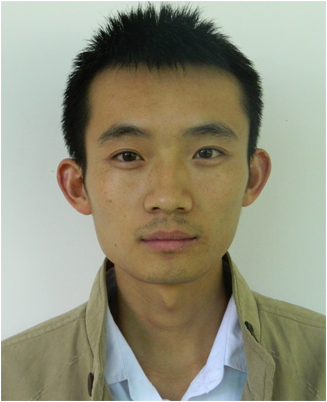 Yunlong Li is a master student at the Institute of Geographic Sciences and Natural Resources Research, Chinese of Academy Sciences. He received a BS degree in geographic science from Dezhou University in 2011. He has been making study on the response of soil respiration to warming and increasing precipitation since 2011.  Yuting Zhou is a doctor student at the University of Oklahoma. He received his bachelor degree in Urban and Rural Planning & Resource Management from Shandong University of Science and Technology in July, 2010, and an Ecology master degree from the Institute of Geographic Science and Natural Resources Research, CAS in July, 2013. His research interests focus on remote sensing and GIS application in ecological modeling.  Pengwan Yang is a master student at the Institute of Geographic Sciences and Natural Resources Research, Chinese of Academy Sciences. He received a BS degree from Wuhan University in 2012.  Zhenxi Shen is an associate professor at the Institute of Geographic Sciences and Natural Resources Research, Chinese of Academy Sciences. He has been engaged in alpine grassland research since 1985. From 1985 to 2004, he worked at the Institute of Northwest Plateau Biology, CAS. He began to work at the Lhasa Plateau Ecosystem Research Station, IGSNRR, since 2005. His research interest includes global change, restoration ecology and physiological ecology. |
|||||||||||||||||||||||||||||||||||||||||||||||||||||||||||||||||||||||||||||||||||||||||||||||||||||||||||||||||||||||||||||||||||||||||||||||||||||||||||||||||||||||||||||||||||||||||||||||||||||||||

